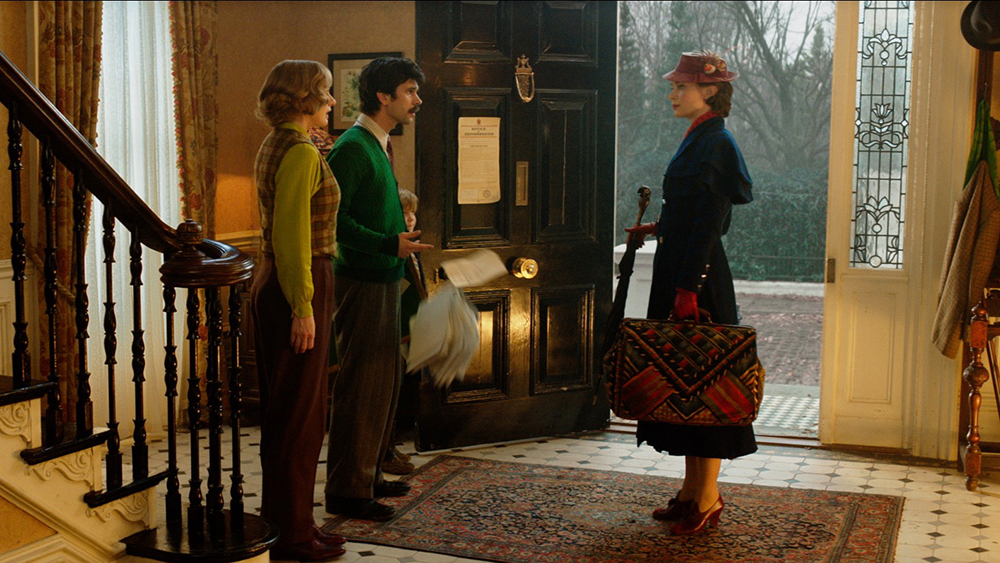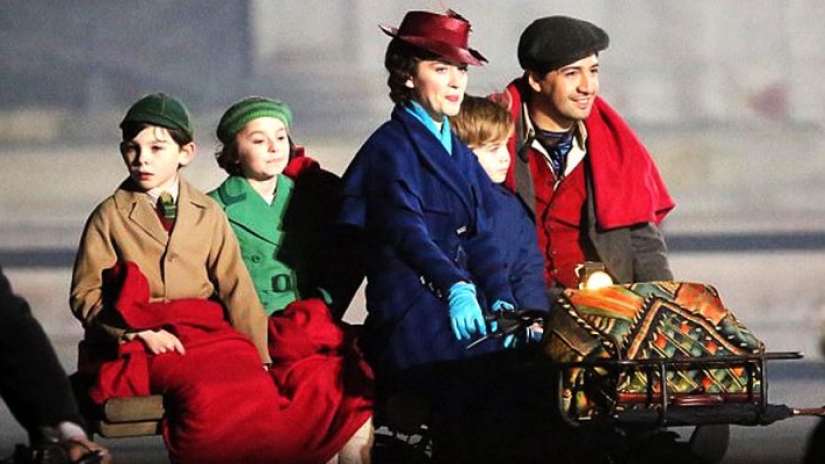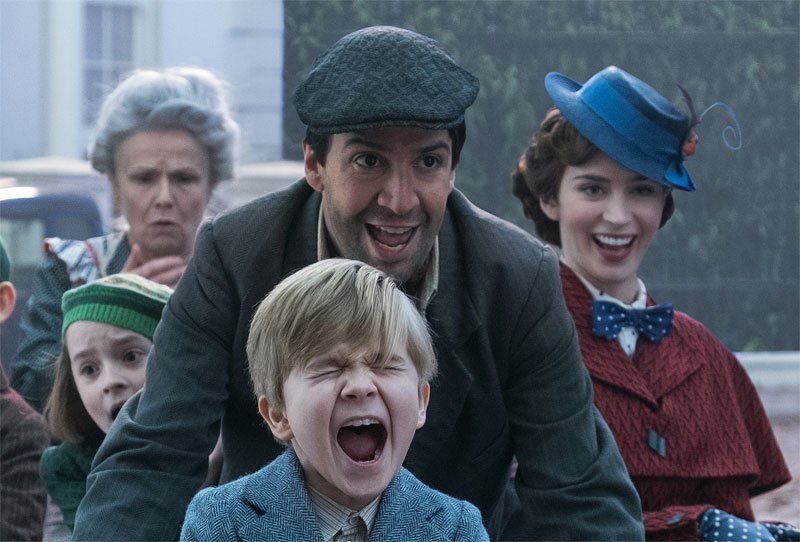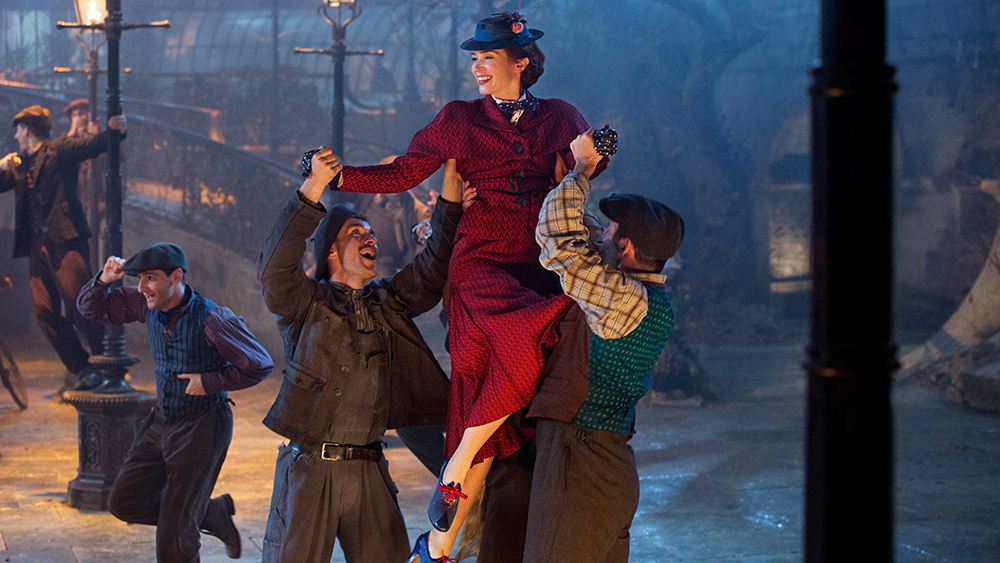Mary Poppins Returns (2018) is the long-awaited sequel to the original 1964 film starring the titular character. Emily Blunt takes over the lead role from Julie Andrews, with Lin-Manuel Miranda supporting as another beloved Cockney lamplighter. As the title suggests, the film follows Mary as she comes back to the family she once left when the kids from the first film are all grown up. Is it worthy of its predecessor, and will it have legs going into Oscar season?

I don’t typically consider myself a fan of musicals. I enjoyed 2016’s La La Land and tolerated last year’s The Greatest Showman, but other than that I tend to dislike the genre. However, I have to respect its ability to completely draw you into its world and charm you with visual and audial treats that no other genre can give. While other genres have to contain themselves to what could plausibly happen in the world, musicals have free reign to “break the rules” and provide whatever thrills they want the audience to enjoy. Movies don’t all have to be gritty, realistic slogs…they can be colorful and exciting and fun, which musicals exist to remind us of.
Mary Poppins Returns has big shoes to fill. The original film starring Julie Andrews is a classic, with songs and performances that endure to this day. The sequel draws frequent homage to its predecessor but also seeks to break new ground itself and establish its value in its own right. All-original songs, charming performances for characters new and old, and a plot that isn’t simply a retread of the original film. Sure, not all of the songs are winners, and only time will tell how memorable the film will be, but I was nonetheless charmed by the film without feeling like they were leaning too heavily on nostalgia. Maybe there was one or two too many references to the previous film, but it’s forgivable considering the film’s tendency to go after maximum emotional impact and joy.

The emotional weight of the film relies on strong characters, and the film does a good job setting up each of the primary characters’ desires and needs. The two children from the original film, Michael and Jane, have grown up into adults and are facing financial trouble as their family home is foreclosed. Michael has written off his childhood experiences with Mary Poppins as make-believe and given up his dream of being an artist to be a banker and become a “proper” adult. As such, his children look up to him and emulate his no-funny-business mentality. Mary Poppins arrives to remind the family of the importance of imagination. (“We’ve grown up a lot!” “Yes, we’ll see what we can do about that.”) Sure, it’s simplistic and predictable, but a good story must set up clear stakes from the outset so we understand what needs to happen for our characters to grow, and this film does that.
The musical numbers are all (mostly) wonderful. Only time will tell if they end up becoming as memorable as the original film’s tunes (I highly doubt it), but they’re all catchy and completely charming. One of the main benefits of musicals is that they can use musical numbers to hide exposition dumps, and I appreciate that the songs doubled as pure entertainment and character/plot progression. The visual journeys the film takes us on are also splendid, including a bath sequence that becomes a voyage on the high seas, and a journey to repair a broken china cup that becomes a wild trip to the music hall. The film plays to its strengths well, not overusing Emily Blunt in these moments and allowing Miranda to let loose with his unique rap-singing that made him famous on Broadway. The one number that fell flat for me was during Meryl Streep’s sole scene; she gives a bizarre accent and completely overacts the moment. Just watch the Academy nominate her for the performance now. Nothing would surprise me with her at this point.

The performances from all the primary actors were also great. Emily Blunt will probably earn an Oscar nomination for her turn as the legendary Poppins, and I never felt like I was watching an actress on-screen. However, some of her mannerisms felt repetitive and vain; I don’t know if Mary Poppins ever spent so much time admiring herself in mirrors in the original. Lin-Manuel Miranda gives a Cockney accent that isn’t completely embarrassing, and does well to emulate the same charm as Dick Van Dyke while bringing his own strengths to the table. I also enjoyed Ben Whishaw and Emily Mortimer as the grown-up Michael and Jane; their casting was brilliant as they retain the childlike physical features that allow them to partake in the wonder of the world without feeling out of place. Colin Farrell plays the troubled villain role well, embodying the Scrooge-like adult while allowing a sliver of humanity to seep in from time to time. There are a number of cameos as well from famous actors like Van Dyke and Streep, some of which work, some of which don’t.
But what really makes this movie is the immaculate set design, costumes, and choreography, particularly in the song and dance numbers. As mentioned before, the film leans into popping colors and visual treats that keep things spritely and fun at all times. I previously believed that The Favourite had Best Costume Design in the bag at the Oscars, but this gives it a serious run for its money. The film also blends different styles of animation during the fantastical sequences, similar to the new Spider-Man film, drawing homage to the famous sequences from the first film and taking advantage of new technologies since its release. Some of the sets are jaw-dropping, from the spontaneous BMX sequence during the lamplighters’ song to the harrowing climb up Big Ben during the climax.

Conclusion
This is as close to a glowing endorsement to a film that I didn’t really care for. I can’t deny the charm of the film, and every technical decision made for the look and sound of the film is just about perfect. Good performances, good music, good set design, solid script. You can’t really ask for much more. I doubt I’ll remember the film in a few months, so I can’t really give it an A, but I’ll give it the maximum score I can otherwise for the strength of the craft alone. Expect a slew of Oscar nominations for this one, and don’t be surprised if it sneaks into Best Picture. It’s exactly the kind of feel-good treat that some voters will gravitate towards.
VERDICT: B+
All image rights belong to Walt Disney Pictures.
Merry Christmas, everyone! My review of Vice should be up in the next couple of days, with If Beale Street Could Talk soon behind. Then I’ll be covering a batch of belated reviews in preparation for my Top 10 Films of the Year list around New Years! Stay tuned!
7 thoughts on ““Mary Poppins Returns” Film Review”